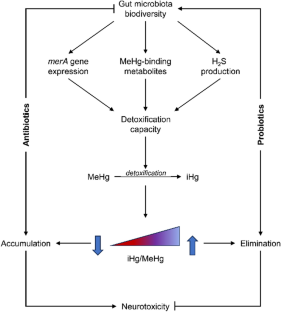Intestinal microbiota protects against methylmercury-induced neurotoxicity
Abstract
Methylmercury (MeHg) remains a global public health issue because of its frequent presence in human food sources obtained from the water. The excretion of MeHg in humans occurs slowly with a biological half-time of 32–47 days. Short-term MeHg exposure may cause long-lasting neurotoxicity. The excretion through feces is a major route in the demethylation of MeHg. Accumulating evidence suggests that the intestinal microbiota plays an important role in the demethylation of MeHg, thereby protecting the host from neurotoxic effects. Here, we discuss recent developments on the role of intestinal microbiota in MeHg metabolism, based on in vitro cell culture experiments, experimental animal studies and human investigations. Demethylation by intestinal bacteria is the rate-limiting step in MeHg metabolism and elimination. The identity of bacteria strains responsible for this biotransformation is currently unknown; however, the non-homogenous distribution of intestinal microbiota may lead to different demethylation rates in the intestinal tract. The maintenance of intestinal barrier function by intestinal microbiota may afford protection against MeHg-induced neurotoxicity, which warrant future investigations. We also discuss studies investigating the effects of MeHg exposure on the population structural stability of intestinal microbiota in several host species. Although this is an emerging area in metal toxicity, current research suggests that a change in certain phyla in the intestinal microbiota may indicate MeHg overexposure.


 求助内容:
求助内容: 应助结果提醒方式:
应助结果提醒方式:


